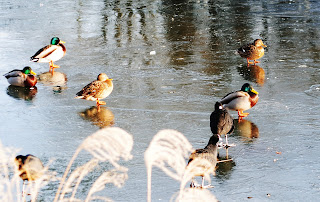Snowdrops (Galanthus nivalis), Witch-hazel (Hamamelis spp) and Dandelion (Taraxacum spp) were all in flower outside in the National Botanical Garden of Wales. Even the female flowers of regular Hazel (Corylus avellana) were glowing red. It was so cold, however, that the Mallards (Anas platyrhynchos) and Coots (Fulica atra) could only stand on the ice.
This blog may help people explore some of the 'hidden' issues involved in certain media treatments of environmental and scientific issues. Using personal digital images, it's also intended to emphasise seasonal (and other) changes in natural history of the Swansea (South Wales) area. The material should help participants in field-based modules and people generally interested in the natural world. The views are wholly those of the author.
Subscribe to:
Post Comments (Atom)
-
I n the UK and US, a pparently popular and successful vegan/vegetarian restaurants are reportedly closing or adding meat to their menus ( ...
-
Early ripening fruit may seem convenient but some folk think it confirms environmental stress. There's also a possibility th...






%20mating%20NWCW.jpg)


No comments:
Post a Comment